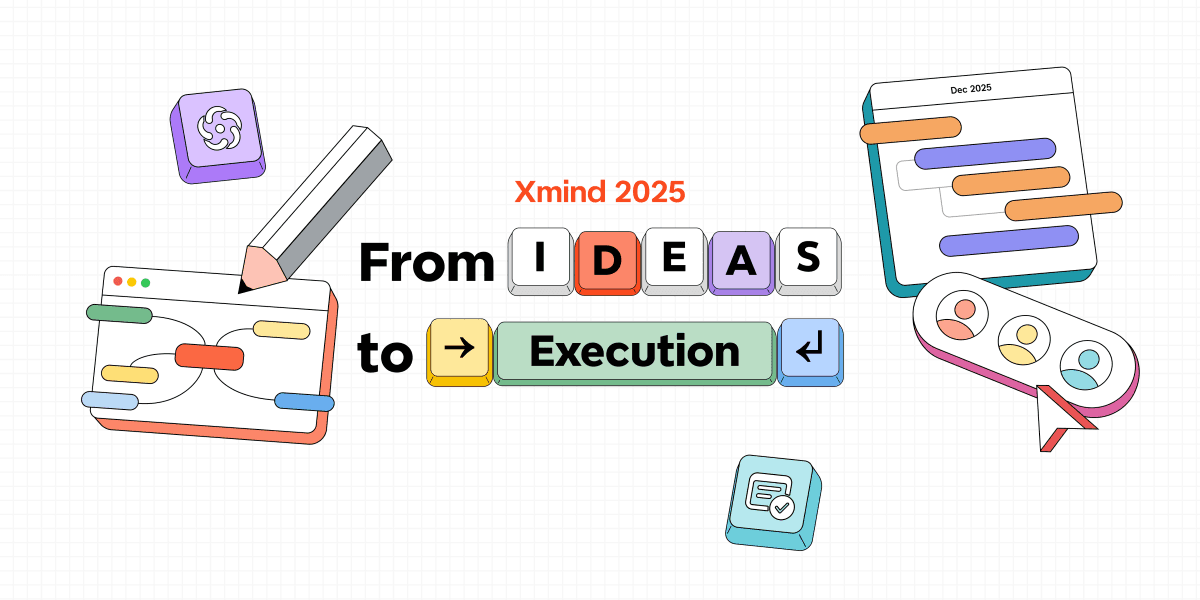2025/09/17
プロジェクト計画の青写真:初めての成功した計画を構築する
明確なロードマップなしで新しいプロジェクトを始めると、圧倒されることがあります。プロジェクトの計画は、プロジェクトの各フェーズをガイドし合理化します。しっかりとした計画がないと、プロジェクトは締め切りの見落とし、スコープの拡大、コストの超過に直面する可能性があります。
この記事では、初めての成功するプロジェクト計画の作成について説明します。基本を学び、役立つプロジェクト計画ソフトウェアのオプションを発見できます。プロジェクト管理のアプローチを再構築する準備はできましたか?プロジェクトの計画設計図をユーザーフレンドリーなビジュアル計画ツールであるXmindと一緒に作りましょう。これにより、プロジェクトの組織化が簡単になります。
プロジェクト計画の基本を理解する
プロジェクト計画は、この数年で大きく変化し、成功するプロジェクト管理においてすべてとなりました。効果的なプロジェクト計画を作成するために役立つ基礎を見てみましょう。
2025年のプロジェクト計画とは?
2025年のプロジェクト計画は静的なドキュメントを超えています。この動的な設計図は、目標、スコープ、成果物、タイムライン、予算、特定のプロジェクトを完了するために必要なリソースを示します。この計画は、チームを開始から終了までガイドする詳細なロードマップとして機能します。
現代のプロジェクト計画には以下があります:
明確な目標と測定可能な目的
境界を持つ定義されたスコープ
作業分解構造(WBS)
マイルストーンと締め切りのあるタイムライン
リソースの配分と予算設定
リスク管理戦略
コミュニケーションフレームワーク
今日のプロジェクト計画は、基本的な約束を果たしつつ適応性を歓迎します。これは、絶えず変化するビジネス環境において特に価値があります。
計画がプロジェクト成功の基盤である理由
研究によると、計画とプロジェクトの成功には強い関連があります。研究は、効率との平均R² = 0.33、全体的なプロジェクト成功とのR² = 0.34の相関を明らかにしています。PMIの研究では、プロジェクトの失敗の主な原因のうち4つが不十分な計画に関連していると示しています。
不十分な計画は以下を引き起こします:
不十分な要件収集(失敗したプロジェクトの40%に影響)
不十分な事前計画(33%)
不明確なビジョンと目標(28%)
詳細な計画は、チームがプロジェクトの真の意味を理解し、成功を阻む可能性のある課題に対して防御するのに役立ちます。さらに、リソース配分を最適化します。それが重要なのは、83%のビジネスリーダーが、適切なリソース分配がプロジェクトの成功を促進すると言っているためです。
プロジェクト管理ライフサイクルの5つのフェーズ
プロジェクト管理ライフサイクルには、アイデアを完了したプロジェクトに変えるために協力する5つの明確なフェーズがあります:
開始: プロジェクトの範囲、実現可能性、目標、タイムライン、および成功基準の定義
計画: 成功した結果に必要なタスク、タイムライン、およびアクションを概説する詳細なロードマップの作成
実行: 成果物を完成させるための計画の実施
監視とコントロール: 進捗状況とパフォーマンスを追跡し、偏差を特定して必要な調整を行う
終了: すべての活動を完了し、プロジェクトを完成させ、パフォーマンスを評価する
計画は、全プロジェクト期間の約20%を占めますが、全体の成功に重要な役割を果たします。
プロジェクト管理計画の主要な構成要素

プロジェクト管理計画には、完全な設計図を構築するために協力するいくつかのブロックが必要です。あなたのプロジェクトを成功に導くこれらの要素を詳しく見てみましょう。
スコープと目的
スコープは、プロジェクトに含まれるものと除外されるものを明確にすることによって、プロジェクトの境界を設定します。PMIの報告によると、プロジェクトの52%がスコープの膨張を経験しています。明確なスコープステートメントがすべての違いを生みます。目的は、SMARTの原則 - 具体的で、測定可能で、達成可能で、関連性があり、期限がある - に従うべきです。これらの原則は、プロジェクトの成功が何を意味するのかについて、すべての人に明確さをもたらします。
タイムラインとマイルストーン
マイルストーンは、プロジェクトのタイムラインにおける最も重要なイベントや成果を示すチェックポイントとして機能します。これらは実際の作業というよりは進捗ポイントを示します。良いマイルストーン計画は、チームを集中させ、プロジェクトライフサイクル全体を通じてステークホルダーが進捗を簡単に追跡できるようにします。
タスクと成果物
プロジェクトは、目に見えるまたは目に見えない成果物を生み出します。タスクとは、これらの成果物を作成するために必要な活動です。これらは外部(クライアント向け)または内部(チーム内での使用)のいずれかである可能性があります。作業分解構造(WBS)は、より大きな成果物を小さい管理可能なタスクに分割し、明確な責任を持たせるのに役立ちます。
リソース配分と予算設定
この部分は、特定のプロジェクトタスクに財務、人材、物理的、技術的リソースを割り当てることを含みます。賢明なリソース配分は、過剰割り当てやボトルネックを防ぎます。予算計画では、すべてのリソースの費用を見積もり、基準を設定し、プロジェクト全体を通じて経費を監視するための追跡メカニズムを使用します。
リスク管理とコンティンジェンシープランニング
リスク管理は、発生する前に潜在的な問題を特定、分析、対応します。このプロアクティブなアプローチは、緩和戦略とバックアップ計画の開発を助けます。リスク管理の専門家は、「リスク管理は、その場で対応するのではなく、事前の準備として捉えられなければならない」と強調しています。
コミュニケーションとステークホルダーの整合性
明確なコミュニケーション計画は、誰がどの情報をいつ必要とし、どのようにそれを届けるかを示します。ステークホルダーをその影響力や関心に基づいて分解することで、コミュニケーションアプローチをカスタマイズできます。このアプローチにより、プロジェクトの目標に合わせて全員が整列します。
初心者に最適なプロジェクト計画ソフトウェア
適切なプロジェクト計画ソフトウェアは、初心者が初めてのプロジェクトに取り組む方法を変えることができ、優れたプロジェクト管理ソフトウェアはその計画を行動に移すことを保証します。ここでは、明確さと機能性を兼ね備えた五つのユーザーフレンドリーなオプションを紹介します。
Xmind
Xmindは、整理されたアイデアを視覚的なチャートに配置するのを助ける、使いやすいビジュアル計画ツールとして光を放ちます。その直感的なインターフェースは、初心者や経験豊富なプロフェッショナルの障壁を下げ、考えを素早くキャプチャし、それらを構造化されたビジュアルマップに変えることを可能にします。このソフトウェアは、プロジェクトの視覚化に秀でており、マインドマップ、フィッシュボーンダイアグラム、組織図、タイムラインなど、幅広いダイアグラムタイプを提供しているため、複雑な情報をシンプルで論理的な方法で提示できます。
プロジェクトマネージャーは、Xmindを特に高レベルの目標を実行可能なタスクに分解し、依存関係をマッピングし、共有目標にチームを整合させるために有用と感じるでしょう。タスクとタイムラインを明確に表示する機能により、Xmindは計画効率を向上させるだけでなく、進行中のプロジェクトの追跡とコミュニケーションもサポートしています。プロジェクト管理を超えて、個人の生産性、学術研究、戦略的ビジネス計画にも等しく有用であり、考えを整理し、アイデアを前進させる必要がある誰にとっても万能なツールです。
Asana
Asanaは、業界で最も低い学習曲線を提供し、非技術系チームに最適です。そのカラフルで使いやすいインターフェースに数分で慣れることができます。Asanaのモダンで実用的なタスク管理システムは、すぐに信頼できるツールを必要とする初心者にとって、非常に魅力的で機能します。
monday.com
monday.comは、そのクリーンでミニマリストなインターフェースでユーザーが自然に整理を維持するのを助け、使いやすさのテストで4.5/5を獲得しました。そのビジュアルアプローチとカラーロジックにより、タスクの優先順位付けが効果的です。試験したものの中でダントツに最もシンプルなプロジェクト管理ツールです。
ClickUp
ClickUpは、カスタマイズオプションと初心者向けの機能を提供します。ソフトウェアは、パワフルな機能を備えていますが、ドラッグアンドドロップのガントチャートとシンプルなリストビューでアクセスしやすくなっています。新しいユーザーには、詳細なビデオチュートリアルが用意されており、基本を網羅する整理された学習パスを提供します。
Teamwork.com
Teamwork.comは、タイムラインを明確に表示するガントチャートでプロジェクト計画を簡単にします。無料プランでは、多くのタスク管理機能が利用できますが、競合他社が安価なオプションから取り除くものが多いです。予算の厳しい小規模チームは、このツールを活用して完全な機能を得ることができます。
Xmindを使った初めてのプロジェクトプランの構築ステップバイステップガイド [プロジェクト計画テンプレート付き]
Xmindをプロジェクト計画ツールとして選びました。ステップバイステップで初めてのプロジェクトプランを作成しましょう。Xmindのビジュアルアプローチは、初心者でもプロジェクト計画を簡単にします。
1. プロジェクトの範囲と目標を定義する
空白のマップから始めて、中心にコアな目標を配置します。そこからブランチを使って、作業の境界を捉えましょう:プロジェクトに含まれるもの、含まれないもの、成功がどのように測定されるか。
ここでは、AIでアイデアを成長させることが、漠然とした概念しか持っていない場合にアウトラインを素早く作成する方法として役立つことがあります。初期の構造が整ったら、それをSMART原則で洗練し、目標を具体的で測定可能にします。最後に、プロジェクトの目的を一つの声明で表現する要約ノードに関連トピックを凝縮します。
2. WBSでタスクを分解する
作業分解構造(WBS)は、大きな野望を明確で実行可能な構成要素に変えます。まず主要な成果物を第一レベルのトピックとして追加し、それから各要素が委任可能な小さなサブトピックに展開します。
明確化のためのヒント:
ツリーチャートは階層を視覚化するのに役立ちます — 成果物を明確な上下に配置し、フェーズとタスクのつながりをすぐに見えるようにします。
マーカーはタスクの優先順位や進捗を示します — 緊急性を示すアイコンや進行状況バーを追加して、タスクの進行を追跡します。
リオーガナイズは乱れたブレインストームを一瞬で整理します — アイデアを自由にキャプチャした後、リオーガナイズを使ってトピックを自動的に整然とした構造に整列させます。
境界は関連するタスクのグループを強調します — デザインやテスト作業のように、つながりのある項目を強調するための境界線を引きます。
製品開発の取り組みを想像しましょう:デザイン → プロトタイプ → テスト → リリース。各フェーズは、デザインにおけるスケッチ、プロトタイプにおけるMVPビルド、テストにおけるQA、リリースにおけるローンチ活動など、具体的なタスクに展開できます。ツリーチャートを使うことで階層は明確に、マーカーで優先順位と進捗を追跡し、リオーガナイズでレイアウトをきれいに保ち、境界線で関連する作業をグループ化します。これにより、全プロセスが簡単にフォローでき、管理しやすくなります。

3. 現実的なタイムラインを作成する
タイムラインは、締め切りを視覚化して達成可能にします。ブランチをタイムラインに変換し、マイルストーンを時系列で配置します。タスク属性を追加し、開始日、締め切り、進捗を監視します。リンクされた活動については、関係性でトピックを結びつけ、依存関係を透明にします。
2か月のキャンペーンを想像してみましょう:マップはクリエイティブブリーフ → コンテンツ制作 → ローンチ → ポストキャンペーン分析を示します。各チェックポイントが見えることで、驚くことが減少します。AIのTo-do機能を使えば、ブレインストーム・リストさえも数秒で順序立てられたステップに変えることができます。
4. 役割と責任を割り当てる
明確な役割は後の混乱を防ぎます。専用のマトリクス図はRACIマッピングに便利ですが、場合によってはもっと軽い手法が適しています:タスクにラベルを追加して所有者を示したり、ノートに名前を記録したりします。
コラボレーション機能は、このプロセスをさらにスムーズにします:
@メンション付きコメントを使って、タスク上で簡単に直接ディスカッションを始めます。
チームワークスペースに計画を保存し、グループ全員が一つの生きたドキュメントにアクセスできるようにします。
リモートセッション時には、リアルタイムコラボレーションをオンにして変更が即座に表示されるようにします。
例としてイベントプランニングを考えた場合、会場のブランチにサラの名前がラベルされ、彼女がそのタスクの責任者であることが明確になります。同時に、コメントにサラの@メンションを追加すると、責任が割り当てられるだけでなく、彼女に即座に通知され、彼女はかんたんに応答や進捗更新ができます。このラベルとメンションの組み合わせで、所有権が透過的になり、チーム全体が追加の会議ややり取りなしで整列し続けることを保証します。

5. リスクと緩和戦略を特定する
リスク管理には専用のスペースが必要です。リスクというブランチを作成し、その下に潜在的な課題を追加します。一部のチームは、影響と可能性をプロットするマトリクス図を好みますが、他は根本原因を探るフィッシュボーンダイアグラムを使用します。
色分けとマーカーは、緊急を要する項目を強調します。リスクが不明確に思える場合は、テキストを強調表示し、AI説明を使用して背景情報を提供したり、防止策を提案させたりします。例えば、「サプライヤーの遅延」が場合によっては祝日渋滞の解説と、「バックアップベンダーを確保する」または「注文を早めに出す」などの戦略を示す場合があります。
6. 計画を最終化し、共有する
いよいよ仕上げて配布する段階です。アウトラインモードに切り替えて、線形で見直し、欠けている部分を確認します。プレゼンモードを使用してスライドとして計画を発表し、スコープからタスク、リスクへの流れをスムーズにします。
コラボレーションのために:
共有でリンクやメールを通じてチームメイトを招待します。
チームワークスペースにプロジェクトを保存し、更新が同期され続けるようにします。
エクスポートオプション(PDF、Word、PPT、Markdown)を利用して、計画をステークホルダーが好む形式で共有できます。
これらのステップで、プロジェクトプランは単一のアイデアから構造化され、協力的で実行可能なロードマップに進化します。この設計図を現実化する準備はできましたか?今日からXmindを使って最初のプロジェクト計画を作り始めましょう。
結論
プロジェクト計画は、成功するプロジェクト管理の命です。この記事は、うまく計画された計画が締め切りの見逃し、スコープの膨張、予算の超過のリスクを減少させる方法を示しています。プロジェクト管理の五つのフェーズ - 開始、計画、実行、監視、終了 - は、コンセプトから完了までのチームを導く実証された枠組みの基盤です。
最初の成功するプロジェクト計画を作りたいですか?Xmindを今日試して、ビジュアル計画があなたのプロジェクト管理アプローチをどのように変革するかを見つけてください。プロジェクトの成功と失敗の差は、最初に確立された計画の質に大きく依存します。
FAQs
Q1. プロジェクト計画の基本的な構成要素は何ですか?
プロジェクト計画には、明確な目標と目的、定義されたスコープ、作業分解構造、マイルストーンを持つタイムライン、リソースの割り当て、予算、リスク管理戦略、およびコミュニケーションの枠組みが一般的に含まれます。
Q2. プロジェクト計画はプロジェクトの成功にどのように貢献しますか?
徹底的な計画は、チームがプロジェクトの本質を理解し、リソースの最適化と課題に対する防御を提供します。締め切りの見逃し、スコープの膨張、予算の超過のリスクを減らし、プロジェクトの成功の可能性を大幅に高めます。
Q3. プロジェクト管理ライフサイクルの五つのフェーズは何ですか?
五つのフェーズは、開始、計画、実行、監視とコントロール、終了です。それぞれのフェーズは、アイデアを完成したプロジェクトに変える上で重要な役割を果たします。
Q4. 初心者はどのようにして効果的なプロジェクトの設計図を作成できますか?
初心者は、目標を定義し、スコープを特定し、マイルストーンを設定し、スケジュールを開発し、リスクを特定し、予算を定義し、役割と責任を割り当てることで、効果的なプロジェクトの設計図を作成できます。Xmindのようなビジュアル計画ツールを使用すると、このプロセスが簡単になります。
Q5. Xmindがプロジェクト計画に適している理由は何ですか?
Xmindは、アイデアを構造化されたチャートに整理するのを助ける直感的なビジュアル計画ツールです。プロジェクトの視覚化に秀でており、チームミーティングのための即座のプレゼンテーションモードを提供し、クラウドサービスと統合するコラボレーションツールも備えているため、目標、タスク、タイムラインのアウトライン化に特に有用です。










